Podcast: Play in new window | Download
Subscribe: Google Podcasts | Spotify | RSS
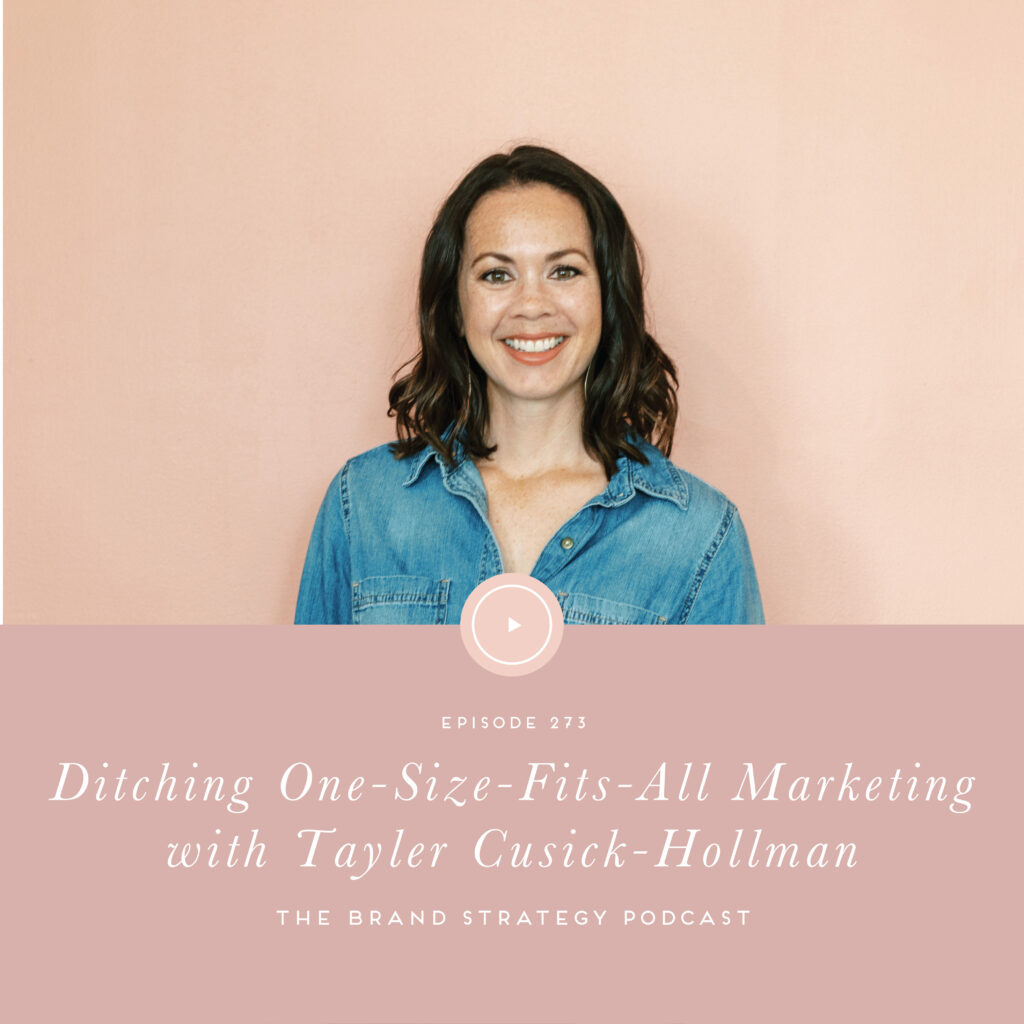
In today’s episode of the podcast, we’re getting real about why one-size-fits-all marketing strategies aren’t necessarily the best solution for your online business’s marketing. I’m joined by marketing consultant Tayler Cusick-Hollman and together we’re exploring a better approach to marketing your creative, service-based business so you can connect with your ideal clients on repeat without losing any impact to a generic marketing approach that was never truly created for you. If you’ve been wondering how to take your marketing to intentional new heights or how to approach marketing in a way that feels more genuine, then today’s episode may be just what you’re looking for.
Tune in for the full episode above!
MEET TAYLER
A marketing consultant and small-business builder, Tayler is the Founder of Enji—though you might recognize her from one of her other companies: TAYLRD Media and Designs and Sourced Co.
In her newest endeavor, Tayler is taking everything she has learned over nearly a decade of helping small businesses with marketing to design and build a suite of online marketing tools that fit your lifestyle and make sense for you. Because, while you didn’t sign up to be Chief Marketing Officer of your business, at Enji, we believe becoming one doesn’t have to be so daunting—and our goal is to empower you with the tools and solutions you need to make more informed decisions, use your resources more effectively, get creative with how you connect with customers, and ultimately grow.
CONNECT WITH TAYLER
https://www.instagram.com/enji_co/
https://www.pinterest.com/Enji_co/
https://www.facebook.com/enjimarketing
https://www.threads.net/@enji_co
YOU MIGHT ALSO LIKE…
Using people-led marketing to generate leads
The power of storytelling in your marketing with Akua Konadu
The magic of surprise and delight in your marketing
FOLLOW ALONG
LIKE THE SHOW?
IN ORDER TO PROVIDE CONTENT YOU LOVE I WANT TO HEAR FROM YOU! SUBSCRIBE TO THE BRAND STRATEGY PODCAST AND LEAVE A 5-STAR REVIEW HERE. THE MORE REVIEWS, THE MORE I’M ABLE TO PROVIDE THIS FREE-ACTIONABLE CONTENT!
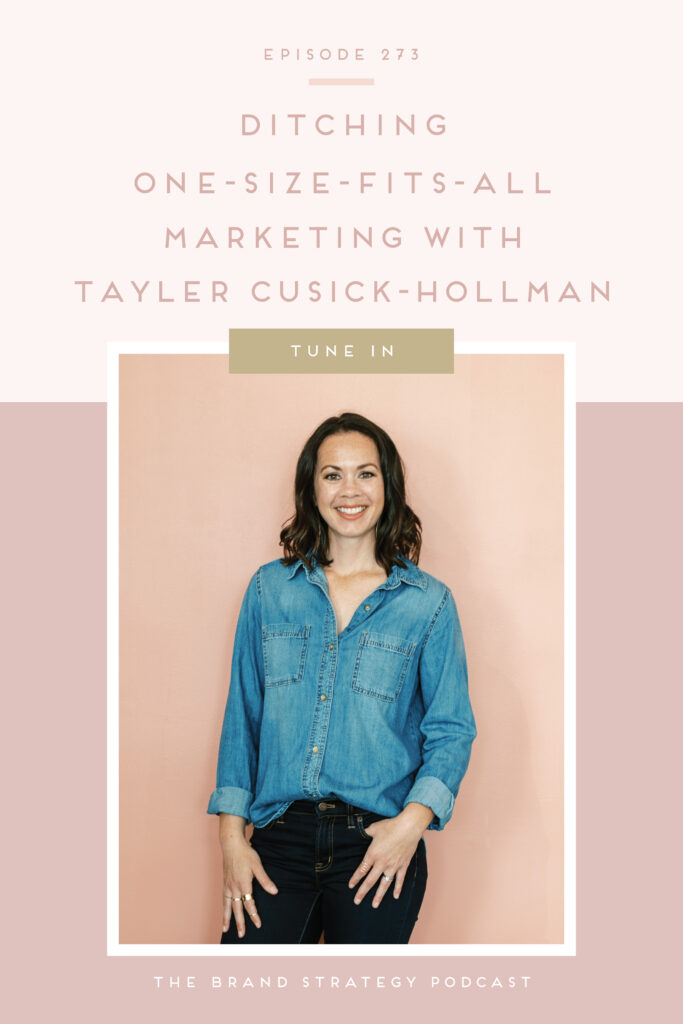
REVIEW THE TRANSCRIPT:
Please note this transcript has been auto generated and may contain typos.
Bonnie (00:07):
Hi, friend, and welcome to the Brand Strategy Podcast, a show created to equip you with the inspiration, encouragement, and clarity you need to build a brand of your dreams. I’m your host, Bonnie Bakhtiari, brand designer, strategist, and founder of the Illume Retreat. From sustainable Strategy to heartfelt Encouragement. Each episode is designed to equip you with the tools you need to chase after your dreams because you deserve a brand that empowers you to do what you love, connects with your dream clients, and offers a deep sense of fulfillment along the way. So grab a cup of coffee and join me on this journey, won’t you
Bonnie (00:45):
Friends? Welcome back to the Brand Strategy podcast where today we are talking about ditching one size fits all marketing with the incredible Taylor Cusick Hollman. We are exploring how one size fits all marketing strategies are oftentimes a very appealing approach for a lot of us as online business owners, but in today’s conversation, we’re gonna be exploring why they actually may not be the magical solution that they’re often advertised to be. But before we get into that, if you haven’t met Taylor before, I’m excited to introduce you to her. She is the founder of Enji. She is a marketing consultant and small business builder, and she is a serial entrepreneur with years of experience. And so over the decade that she has been in the online business space, she is focusing on helping small businesses with marketing to design and build a suite of online marketing tools that actually makes sense for you and actually fit with your lifestyle. So Taylor, I’m so excited to have you on the show. Thanks so much for joining me. Thank you
Tayler (01:51):
So much for the invitation. I love, you know, when you have an online business, one of the cool, really cool things that people who don’t have online businesses are like so confused about is how do you end up with all of these internet friends all over the country? So I’m so thankful that the internet has connected us and that now I’ve got a new friend in Texas,
Bonnie (02:12):
I absolutely feel the same, and I am really excited for us to get to chat a little bit more about this topic. And actually this is a topic that, um, I think sparked because I saw you share a post on Instagram about one size fits all marketing. And I think, you know, we kind of went back and forth in these d in the dms a little bit talking about, you know, our own experiences and how, you know, we’re not necessarily the biggest fans. And, um, so it that’s such a beautiful example of how the internet brings us together and like sparks these really fun conversations that, you know, might not happen if we didn’t have access to tools like that.
Tayler (02:52):
Totally, totally. It’s, it’s always just the highlight of my day when something seemingly small turns into this, you know, great collaborative opportunity. So I’m really excited to have this conversation with you today.
Bonnie (03:05):
Me too. Well, before we dive on in, if you’re up for it, uh, I’d love it if you could share a little bit more about who you are and what you do.
Tayler (03:14):
Yeah. You know, I love to take these kinds of opportunities to help people understand why am I even here as a guest, right? Like, because I think that there’s, this very much ties into the conversation we’re gonna have today in terms of who you should be listening to, who has authority over a space and, and who potentially can be the right guide for you. And so I think it’s really important for people to understand what my background is and why, you know, you should even spend maybe two seconds listening to this conversation. Um, but really the, when push comes to shove, I have been doing marketing since 2015 full-time as an independent marketing consultant. And that time is, has 100% been spent on working with small creative businesses, most of them service-based, um, and many, many of them online based. And so I know that for everyone that’s listening, you’re probably like, oh, that’s me, .
Tayler (04:21):
Right? Um, so, you know, I think it’s, it’s really great to have an opportunity to talk to other people who have shared experiences and, and this is very much my shared experience with everyone tuning in today. And so, you know, the, I actually had a friend who asked me the other week, she’s like, you should add up how many, like, approximate how many hours you’ve spent doing marketing as a consultant. And so I think like a lot of you, you know, a the thought of a 40 hour work week seems like this that would be great if I only worked 40 hours a week. And so I added it all up. And in the past eight years I’ve spent upwards of 20,000 hours doing marketing, which when I saw that number, I was kind of like, is that real ? Have I really spent that much time working over the past eight years?
Tayler (05:17):
Which is slightly depressing, but also great at the same time. Um, but I think I share that because I really wanna highlight the fact that I’ve been doing marketing and not just, um, you know, sitting in the, the proverbial white ivory tower with a, a team of folks behind me doing the marketing on my behalf. I’m the one who’s boots on the ground needing to come up with the plan and actually execute all of the, the tasks that are in the plan. And, and that’s very much what small creative business owners need to do as well. And so, um, I am, I’m here right alongside all of you on the struggle bus a lot of days and trying to figure out ways to really be, IM effective and impactful and smart with my time when it comes to marketing. And so, um, that was really the, the big impetus for coming up with what Engie would be. And so I’m really excited to be taking everything that I’ve learned through experience and the experiences of, of the folks that I’ve gotten to know and develop a, a piece of technology that hopefully is really gonna help us all do what we’re trying to do.
Bonnie (06:29):
That’s absolutely amazing. Now, knowing that you’ve been in this space since 2015, I mean, wow. Like just the online space and, and the tools that we have access to as business owners, I mean, I just can’t, it’s hard to wrap your head around how many changes the industry has gone through since 2015 and you know, like the rise and fall of all these different social platforms. And so I I’m sure that in those years you have seen a thing or two about, um, you know, marketing and not just like the strategies and the tools, but also the formulas and the language that, uh, marketing experts have been sharing. So my question with all of that is, uh, in your experience, you know, this concept of one size fits all marketing, how, how effective is that actually, you
Tayler (07:28):
Know, we all would cross our, our fingers and toes, and pinky promise to other people that it would be really great and it would be, you know, the silver bullet to the problem that we’re all facing. But in reality, it’s, it’s not really the most effective thing, are these kind of steal my strategy sort of approaches. And I think we all have seen ads that use that exact phrase, you know, whether it’s a, a lead for a lead magnet or a mini course or something. There are so many experts out there saying, you can just take what I’m doing and and do it and it’ll be great and you’ll have 500,000 Instagram followers and you’ll make six figures off of your next launch. And, um, you know, the one of the phrases that I, I say with love, but it’s lying liars who lie like , it’s not gonna be that sort of impact or you’re not gonna see that sort of impact as a small business owner when you try to replicate someone else’s strategy who’s really working with a completely different set of tools, talking to a completely different audience, um, and just has so many other factors that are not the same as what you have.
Bonnie (08:47):
I couldn’t agree more. I think that just from my perspective, what happens when, and I’ll, I’ll raise my hand, you know, know I’ve absolutely been dazzled by the like one size fits all formula, the step-by-step strategy that’s, you know, promising me this like effortless kind of overnight success. Um, you know, that, that marketing is, is shiny and persuasive for a reason, but I I’ll say this, it’s that our businesses are so unique and in a lot of cases, so individual to who we are as the CEOs and the creative forces behind them, that oftentimes a lot of the nuance that is required for our marketing to be truly successful gets lost when we are implementing kind of this, this play by play sort of blueprint. Um, so Taylor, in your experience, if marketing is not really conducive to this kind of one size fits all sort of template, what is it instead
Tayler (09:53):
The, I love this question because I’ve had, I’ve had this conversation with more than a few people over the last, uh, six months especially because I don’t know what, what changed about me, but it just kind of became one of the things that really, um, like agitated me is that, and the answer to your question is that marketing is not a formula. Marketing is an experiment. And I say that because just like, I mean, if you think about, I mean, I don’t think we were doing serious science experiments in elementary school, but maybe you were, maybe you went to an over , maybe you’re an overachiever who went to an overachieving school. Um, but when you think back to when you were a student, you and you were learning about science experiments, you had to set up a hypothesis and your experiment included variables that you were gonna test.
Tayler (10:44):
And that’s really what marketing is. You’re setting up a hypothesis, which is a guess about what you think might happen if you do these certain things. So something like, I think I’ll get, you know, X number of leads if I do Y and Z, and then your, your variables are your marketing channels, your tactics, your audience, your messaging, right? All of these things. But what makes the marketing experiment way harder than the ones that we did in school is that you don’t have this clean cut dependent independent variable set up. And I know I just got real nerdy with that. So if you, we don’t have to go back to, you can google what those are and how that fits into a, the scientific method. Um, but when it comes to the marketing experiment, you have too many variables in one experiment. And so it’s really hard to pinpoint what’s the magic piece of this.
Tayler (11:51):
Um, and that’s what I think these one size fits all formulas are really trying to sell you and make you think is that if you do, you know, Y and z, you will get X, but everybody’s y and z is a little bit different. And there are so many parts of marketing that are, that are connected. Um, I think a great example is a landing page when we’re talking about advertising. And I’d love to, to kind of hear your thoughts on this as well is, you know, I’ve, I’ve definitely da more than dabbled in advertising over the years, and I’m not an advertising expert. That’s the big asterisk to all of this. It’s not the space that I like live and breathe every day of my life. But you know, when you get to the point of your advertising experiment where you think, okay, I I don’t have an ad problem.
Tayler (12:49):
My ad is getting seen, it’s getting clicked on, so that’s clearly functioning. But when people are landing on my landing page, I don’t, I’m not seeing the types of conversions that I’d like to see. And so if we look at the landing page as one of the spaces that you can have multiple variables, this is, this is a great example. ’cause it’s like, is it the design that’s not working great? Is it the copy, is it the offer? Right? There are just too many options or things to think about and, and tweak in order to get to the point where you might even have a chance of looking at this landing page as as a bit formulaic in getting what you want. So, uh, have you had that experience as well with, with any sort of advertising that you’ve done?
Bonnie (13:39):
Oh, absolutely. And you know, full disclosure, I I have not utilized paid advertising in quite a while now, so I, I’m not currently experimenting with this anymore, but in past years I have invested a lot of time and a lot of money in, in paid advertising. And what I found, and, you know, as a professional designer, I think I may be hyper fixated on some of these things more than like the average like creative or online business owner does. But with landing page design, there’s so many aspects of that that, that might need to be tweaked, that should be changed. And so you kind of, it, you, you have to kind of keep yourself kind of playful and curious with it because you’re going to find that you’re running all of these different tests and you’re, what you’re doing is you’re experimenting with it in real time and you’re seeing, okay, did this landing page design convert better than this one?
Bonnie (14:42):
If so, why do I think that is? You know, is it the layout? Is it the colors? Is it, you know, the use of, uh, you know, kind of like headlines and pull quotes or is it the copy? Did this copy, is this copy more, uh, relational or more persuasive or more appealing? You know, there’s so many different things that go into it. And I think that to some people that sounds really exciting and it’s like, wow, there’s all this possibility. And if you’re the kind of person where you’re excited by possibility, there’s a ton for you to kind of play with. But if you are the kind of person that you hear me talking about all the different variables that could go into that, and this is, you know, just one very niche example, but if you hear that and you start to kind of feel overwhelmed of like, whoa, that’s a lot for me to think through, and that’s a lot for me to be playing with and testing.
Bonnie (15:34):
You know, I don’t want you to get overwhelmed with this. It’s, you know, it, it’s not meant to be this thing that is hugely stressful and is this constant drain of your time and energy and your resources. I, I think, at least from my perspective, treating your marketing like a series of experiments is meant to be engaging, is meant to be enlightening. It’s meant to lead you to an outcome where you are finding the data that will drive the results that you want to see. But that’s coming from, you know, I’m not, I’m not a professional marketer, this is just, you know, these are just my thoughts from, you know, the last however many years I’ve been doing this. Um, so Teyl, I’d be curious to hear like what your thoughts on that are.
Tayler (16:27):
Yeah, you know, I think as you were talking, I was, my, my brain went to the whole, like, I’m collecting my thoughts. , when you think about the differences between how a small business owner treats their marketing and a market and a marketing department treats their marketing like at a larger company, marketing professionals who went to school for it and are employed by, you know, big fancy companies with big fancy budgets and whatnot. It is, it is almost a given that almost everything that you do from a marketing perspective is going to be what they call AB tested. And so that is, that’s the answer to this question, right? Like, that’s the thing that puts a pin in it, whether or not marketing is a formula or if it’s an experiment. Because the folks who are, who have gone to school and all they do professionally is marketing, they are constantly ab testing versions of their marketing within one particular campaign.
Tayler (17:39):
So like, does, does this visual work better than that visual? Does this headline work be better than that headline? And so I think that for some, I don’t know what it is, but for some reason, independent online business owners have got it in their head that we somehow can get away without this experimentation. And I loved what you said about, you know, we don’t wanna be having to expend so much energy every time we sit down to do marketing and that some people are gonna find that thrilling and some people are gonna wanna bury their heads in the sand over it. Um, but I, I promise you, if at the, at the end of the day, if you sit down and you’ve created a a realistic marketing strategy for yourself with very realistic expectations of what you are capable of doing as a single person, then this gets a heck of a lot easier.
Bonnie (18:39):
So knowing that so many of us as online business owners don’t have that professional background in marketing, and so we don’t necessarily have all this experience of of running all these ab tests, what are some steps that kind of the average creative could take to start setting up, you know, their own marketing as a series of experiments?
Tayler (19:03):
You know, this one, people are probably gonna slightly roll their eyes at me ’cause they’re like, oh man, someone else just telling me that the key is just to get started. Um, but that’s really the case because there’s, when we’re talking about experiments, there is no right or wrong answer. You are trying to figure out what the answer is. And so I think a really great place to start with how, you know, answering this question of how do I figure out what my next marketing experiment is going to be, is to take a half step back and look at all of the, you know, proverbial marketing cards that you have on the table, and just think about what you think might be related. Like, does, does your website traffic and the number of visitors you get every month have any sort of impact on the number of leads you’re getting?
Tayler (20:03):
Or if you have a, an opt-in or a lead magnet and then you have a, you know, an email sequence set up on the back end of that, does, is there a correlation between the number of people who are opting into your freebie, completing your email sequence and then becoming paying clients? So it’s just really thinking about what are you doing and what might be related to one another. And then the really, I think the more important part of this experiment is not just setting it up, but it’s doing the thing that I know almost no one is doing , which is tracking your metrics or, you know, know your KPIs, your key performance indicators to actually know what’s going on with your experiment. Because what I see a lot of, you know, business owners doing is just operating off of their gut all of the time and their intuition and like, does this feel like it’s working?
Tayler (21:07):
But that the answer doesn’t lie in, in that space. The answer can be guided by your intuition, certainly 100%. Like I am someone who relies on does this feel like the right thing to do at this moment? I rely on that all the time, but when I go to make the final decision, I’ve tracked my numbers so that I can’t really convince myself that, you know, if tooth, if my numbers and my intuition are in direct conflict of one another, then I can’t really ignore the writing on the wall. So I think that’s the, the most important piece of setting up your own marketing experiment is knowing, okay, here’s what I’m gonna do, but these are the, you know, one to five things, meaning numbers that I’m gonna track in order to know the impact of this experiment on my business. And then that’s where you can really start having any sort of chance at finding a formula that works for you because you’ve done the experimentation first.
Bonnie (22:19):
Mm-hmm. I love that advice of, you know, finding the formula that works for you. And I, you know, certainly over the years in my business, there have been strategies that I’ve been able to, you know, kind of not rinse and repeat, but take as kind of a foundation and ju it up to meet my new goals or, you know, infuse it with new, new visuals or new copy or, you know, something like that. And then, you know, launch and sit back and see what the response is and analyze that data and decide, Hey, is this something that’s, that’s working? And you know, from that, it has shown me how I may not be hugely successful if I am buying into other people’s formulas. But if I am being a, a really diligent student of my own data and looking at what those numbers are telling me in my own business, then I actually can start creating some formulas and I can start looking at patterns for my marketing that, that work for me. Now, you know, that’s, that’s because I’m looking at what is true in my business and what, you know, my audience responds to and what I am able to invest my time and energy in, in doing. But it’s, it’s something that is, in my experience, well worth the time that it takes to, you know, study the numbers and pull that data and make sense of it all.
Tayler (23:53):
Yeah, I love what you said. The the pool quote from , from what you just said was, you have to know what’s true to your business and that I, you know, bravo round of applause standing ovation. That is , that’s the mic drop moment for sure. And you know, when it comes to tracking your numbers, there’s, there’s not really been a super easy way to have your numbers presented to you in a way that’s very easily digestible. And, you know, I, for years, years and years and years, used a spreadsheet to track all of my KPIs and it, it functioned , right? Like I had the months across the top as my columns, and then I had all of my KPIs down running down the right side as my rows. And every month I would go in and plug in all of my numbers and you know, I was trying to color code things to let myself know if I was on track or off track.
Tayler (24:49):
But when push came to shove, it was really hard for me to find any patterns. And, you know, you mentioned patterns just not too long ago. And so when I was sitting down to think about, you know, what NNG was gonna be having something that made way more sense than a spreadsheet full of numbers. And I mean, raise your right hand if you’re someone who should never be asked to write a formula within an Excel spreadsheet. ’cause that’s me, , that’s also me , right? So I was literally just looking at a sheet of numbers. Um, and so I was like, I need to come up with a way that people can actually really be empowered to see the patterns within their own business and see what is true in their businesses. And so our, the K P I tool that we built is you enter your numbers just in a clean sort of spreadsheet like thing, but then it creates these visual graphs.
Tayler (25:50):
And so you can have charts that, you know, within the, a snap of your fingers you understand are, are, is this K P I trending up? Is it trending down? If I’ve got two KPIs that I’ve put into one chart, are they related in a positive way or a negative way? And so when I have the opportunity to speak with and meet small business owners in person, um, it has become painfully clear to me that none of y’all are tracking your KPIs . And so I, this is, I’m gonna get on my soapbox and I really, really, really want everyone to start doing this ’cause this is the thing that you can do to make the smartest decisions for yourself with confidence.
Bonnie (26:36):
Hmm. I love that advice and I know that it’s not necessarily the sexiest piece of advice. I know that tracking your KPIs doesn’t sound like the most fun sort of thing to do, but it’s one of the things that, you know, years ago when I started looking at how I was running my business and how I could be running my business less like a hobbyist and more like a c e O, that was one of the shifts that made a huge difference for me is instead of just marketing my business with like hopes and dreams and good vibes, actually, like keeping the hopes and dreams and good vibes, but then like backing them up with the numbers mm-hmm. , that made a huge difference. And, and the confidence that I felt about making data informed decisions for my business, and then also, um, it made a huge difference in the, uh, amount of profitability that my business was experiencing.
Bonnie (27:32):
Because instead of feeling like I was just constantly throwing spaghetti at the wall to see what was gonna stick, I was able to look at, okay, where am I spending my time in my marketing? Where am I showing up online? And are those, are those outlets, are those tools actually profitable for me? Are they actually converting for me? So I know that hearing the advice of tracking your KPIs may not be the most fun thing you’ve ever heard on this podcast, but I promise you if you start doing it, information, information is, is empowering information is, is a gift. And so having that at your disposal and being able to look at that and then make sense of that over time, uh, it’ll change the way that you approach your marketing from my perspective
Tayler (28:21):
100%. And if anyone who’s listening has ever wondered if their marketing is getting them results, whether or not they were taking a steal my strategy approach, or they’ve come up with their own marketing experiment, if you are wondering whether your marketing is getting you results, the only way that you know is by tracking your metrics.
Bonnie (28:44):
That’s the, that’s the second mic drop moment from today’s conversation is Yep. Mm-hmm. . Yep. I, I mean, what else can I add to that? Because you’ve said it all . Um, I always love to ask as kind of a final question on this show, if there’s a piece of advice about, you know, remembering that your marketing is an experiment and hopefully, you know, an experiment that can be full of some playfulness and some levity and some fun, if there’s a piece of encouragement that comes to mind for you, what would you like to share with those who are tuning in today?
Tayler (29:21):
Oh, boy, this is a good one. And, uh, I am a, I am a happy person who’s encouraging, but I am also a hardcore realist. And so this is, this is where this is gonna go. But you know, my biggest piece of advice is to know that failure is baked into this process. You cannot avoid it. We are all going to make missteps and not the best decisions at some point in this experiment of marketing. And, you know, I I, I’d like to share that even though I’ve been doing this for eight years at, at the time of this recording, I have made mistakes. I have made plenty of mistakes. And just recently when we launched Engie, I did a couple Instagram stories asking my audience what kind of lead magnet or like freebie piece of, uh, of information or resource they would be excited to get.
Tayler (30:21):
And so I put out a bunch of polls and people voted. And so I, I created the one that the people told me they wanted, and I put it out there and I started promoting it, and I got crickets, , no one, no one actually wanted the thing that they told me that they wanted. And so I took it down because as a part of the experiment, I was like, I am not getting the results that I thought I would from this, so I’m gonna stop expending any energy or putting any energy into it. And so now I need to go back to the drawing board and think about what, what’s the next lead magnet that I’m gonna try and I’m gonna learn from this mistake, and I’m gonna take those lessons and I’m gonna push forward and I’m gonna try something new and I’m gonna try it again.
Tayler (31:09):
And if that one fails, guess what? I’m gonna try it again. And so that’s really the, the big thing to know is that failure is not, I don’t want anyone to think about failure in this space as they would in other aspects of their life, because everybody fails at some point when it comes to marketing. And those of us that succeed are willing to get up, you know, do the cliche, brush your, brush your shoulders off and keep moving forward. And so that’s what I hope everyone can really accept and, and, and not let their perfectionism beat themselves. Like, not take the perfectionist that I know lives pretty much in all of you, because I think you have to be a perfectionist to have, you know, a creative online service-based business. Um, but I hope that that perfectionism doesn’t prevent you from continuing to get better over time.
Bonnie (32:09):
Hmm. I absolutely love that advice. And actually, I have a post-it note on my computer monitor that I was looking at as you were sharing that advice about perfectionism. And it says that perfection is costing you something. And absolutely, when we engage in those, you know, perfectionist tendencies, it can be costing us something. It can be taking something from us and in, and exactly what you were just talking about, if we are so afraid to fail that we, you know, refuse to take repeated, you know, repetitive sort of consistent action, then we miss out on gathering that data, on figuring out what works. And we also miss out on having the impact that we can have through a successful marketing strategy that connects us to our ideal client’s consistently. So thanks for reminding us of that Teyl. That’s a good
Tayler (32:59):
One. Of course, there’s a, there is a perfectionist that lives in all of us, and, and she, she, he, they, they are great. Sometimes they are our worst enemy and others. So, um, I love that, that post-it that you have, I should, I should create that for myself as well,
Bonnie (33:14):
. Yeah. Feel free to, feel free to swipe that one. Spell that one. Yeah. You know, put it wherever is gonna encourage you. That’s, it was one that just, I can’t even remember where I heard that, but it, it was the message that I needed and it has mm-hmm. continued to be the message that I need. So , I, I know that folks who are tuning in today are gonna want to follow along with you and what you’re doing with Eng G and all the great things. So where can the people find you online?
Tayler (33:42):
Yeah, so I have, I have many corners of the internet, but the corner of the internet that I am spending the most time in right now is, is on Instagram. Um, as a, as a good old geriatric millennial, should be on Instagram. Um, but our Instagram handle is ng co and that’s e n j ico co. Um, and our website is just ng.co. But, um, you know, I, I am a person with 700 tabs open on my browser any given day. So if there’s a way to get in touch with me on online, just throw that hail Mary. ’cause I’ll, I’ll, it’s not actually a hail Mary, I will be on the other end of it. . So .
Bonnie (34:25):
Awesome. Well, and of course, to those who are tuning in, I’m gonna have Olive Taylor’s links in the show notes, so you’ll be able to head on over there. You can go to brand strategy podcast.com, click on the latest episode link, and in today’s episode post, you’ll be able to find, you know, not only a recap of our biggest talking points and all of Taylor’s info, but you’ll also find a full transcript of the conversation if that’s something that would be at all useful to you. Um, Taylor, thanks so much for joining me and having this great conversation. It’s been so enlightening and honestly, tons of fun. Um, so I’m really appreciative of your time and expertise in this way.
Tayler (35:04):
Thank you so much for the invitation and right back at you. This is such a great conversation and I hope everyone had as much fun. I have a big old smile on my face. I know none of you can see that. Um, but I had such a great time, uh, spending part of my day with you today,
Bonnie (35:19):
, I have a big smile on my face as well. And so Taylor, thanks again for those who’ve been tuning in. Thanks for listening. I always appreciate you. And as always, I’ll be cheering y’all on from Waco. Thank you so much for joining me
Bonnie (35:36):
Today. Friends, before you go, I would be so grateful to receive your feedback on the Brand Strategy podcast. If you enjoyed this episode or the podcast in general has helped you grow your brand, I’d really appreciate it if you left us a review in iTunes. Your positive reviews enable the brand strategy podcast to continue to grow and reach like-minded creatives just like you. Thank you for all your support and encouragement as together we pursue building brands with purpose and intention. Until next time, I’m cheering you on from Waco.
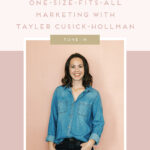
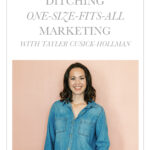

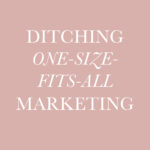





leave a comment